Cultural Tourism
Rural Tourism Resort-style Park Project of Jilin City
1. Introduction to the Project
1.1 Project background
1.1.1 Product introduction
The project relies on the abundant agricultural and tourism resources in Jilin City to construct three major functional areas: the Smart Agriculture Demonstration Area, the Rural Joy Area, and the Ecological Health Preservation Area. Through diversified operations such as “tourism+agriculture”, “tourism+poverty alleviation”, and the combination of tourism and culture, commerce and other industries, it aims to create a leisure and health resort integrating agriculture, culture and tourism, enhance the value of the agricultural industry, increase the participation of experiential tourism, and become a new hotspot for leisure tourism in Jilin City.
1.1.2 Market prospect
(1) The current situation of leisure agriculture industry
Leisure agriculture is a new form of agricultural industry that is based on agricultural production, rural style, rural life, and rural culture, and develops multiple functions of agriculture and rural areas, providing services such as leisure sightseeing, agricultural participation, and rural experience. At present, there are various models for the development of leisure agriculture in China, mainly including the comprehensive experience model, leisure travel model, health and wellness model, folk tourism model, science education model, sports and leisure model, exhibition agriculture model, etc.
Figure 1 Main Models of Leisure Agriculture
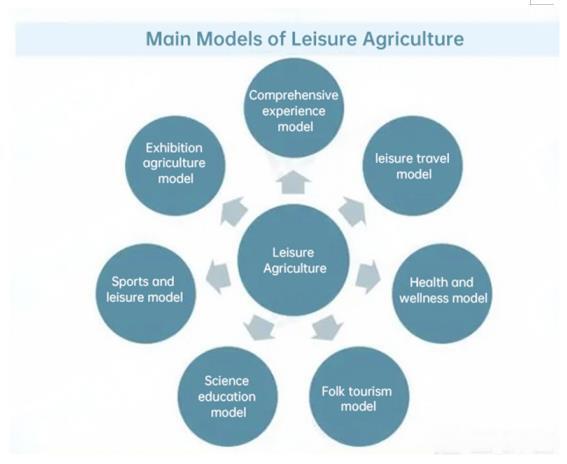
In recent years, with the improvement of living standards of urban and rural residents and the upgrading of consumption structure, the demand for leisure agriculture market will further increase. Especially under the promotion of the rural revitalization strategy, the country has introduced more supportive policies to promote the rapid development of the leisure agriculture industry. Data shows that from 2015 to 2019, China’s leisure agriculture revenue maintained a continuous growth trend; in 2020, the revenue of leisure agriculture in China was 604.9 billion yuan, a decrease of 28.8%. This was mainly due to the impact of the pandemic, which suppressed the demand for residents to travel abroad and severely impacted the leisure industry; with the lifting of restrictions on travel, the long suppressed tourism consumption sector has seen growth, which in turn has driven steady growth in leisure agriculture. By 2023, China’s leisure agriculture revenue has reached 840 billion yuan, becoming an impressive sector in the tourism industry.
Figure 2 Operating Revenue of Leisure Agriculture in China from 2018 to 2023
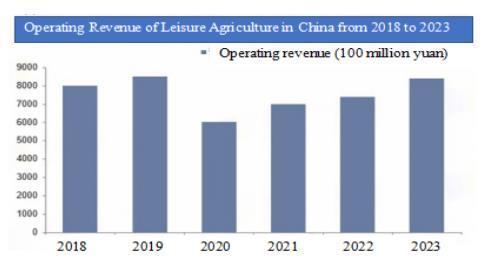
Currently, the popularity of leisure agriculture is still concentrated during holidays, and tourist groups are more inclined to choose leisure agriculture areas closer to the city for sightseeing, fruit picking, experiencing farming, understanding farmers’ lives, enjoying local customs, and even accommodation and vacation. At the same time, more and more agricultural entities are beginning to develop leisure agriculture, and a number of high-quality leisure farms have emerged on the market, with the increasingly refined division of labor. By the end of 2023, approximately 500000 farmers in 14.7% of villages across the country have engaged in leisure agriculture and rural tourism, receiving over 3 billion tourists annually.
Figure 3 Reception Capacity of Leisure Agriculture of China from 2018 to 2023
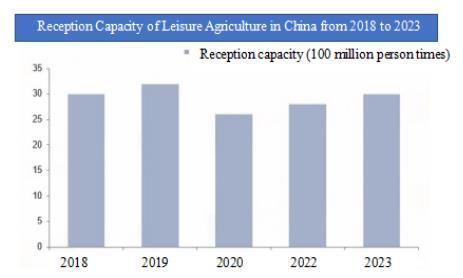
Leisure agriculture in China started in the mid-1980s and spread from Europe, America, Japan, Taiwan, China, China and other places. After more than 30 years of development, it has entered a stage of rapid growth, roughly going through four stages: germination, start-up, growth, and acceleration. At first, the main forms of consumption in leisure agriculture were eating farm food and living in farm houses. In the 1990s, leisure agriculture gradually developed into experiential agriculture that combines sightseeing and harvesting. In the 21st century, the development speed of leisure agriculture has accelerated, the scale has continued to expand, and the number has gradually increased. A number of leisure agriculture villages, modern agriculture demonstration parks, and leisure sightseeing agriculture parks have emerged nationwide. Since 2011, driven by national policies and market forces, the development of leisure agriculture has flourished, with outstanding achievements.
Leisure agriculture is a new industrial form of modern agriculture and a new consumption form of modern tourism. Vigorously developing leisure agriculture is of great significance for promoting rural economic development, adjusting agricultural industrial structure, realizing agricultural modernization, and comprehensive rural revitalization. It is an important industry for promoting the integration of primary, secondary, and tertiary industries and advancing rural revitalization. In recent years, in order to promote the development of leisure agriculture, the country has introduced multiple policies and measures, such as the Notice on Carrying out the Application and Monitoring of Key Leisure Agriculture Counties in 2023 issued in June, 2023, which mentioned the need to continuously develop various agricultural functions, tap into the diverse value of rural areas, vigorously implement high-quality rural leisure tourism projects, promote moderate resource aggregation, and promote high-quality development of leisure agriculture. In the Implementation Opinions of the Central Committee of the Communist Party of China and the State Council on Effectively Promoting the Comprehensive Revitalization of Rural Areas through Learning and Applying the Experience of the Thousand-Village Demonstration and Ten-Thousand-Village Rectification Project, released in February, 2024, it is proposed to implement the action of improving leisure agriculture, build a number of national key counties for leisure agriculture, select and promote China’s beautiful leisure villages and boutique scenic spots for rural leisure tourism, and develop differentiated rural leisure tourism products and services.
(2) Market trends of leisure agriculture
The market concentration of leisure agriculture is constantly increasing, with major competitors including large agricultural enterprises, tourism companies, local governments, and various leisure agriculture operators (such as rural tourism, agricultural sightseeing parks, etc.). These competitors have different resource endowments and competitive advantages, such as agricultural resources, tourism resources, financial strength, brand influence, etc. Large agricultural enterprises and tourism companies usually have stronger financial strength and brand advantages, which can dominate the market.
The competition in leisure agriculture exhibits significant regional characteristics. Due to their unique resource endowments, cultural heritage, and climate conditions, different regions have formed their own distinctive leisure agriculture styles. For example, the eastern coastal areas, with their unique geographical advantages and relatively complete infrastructure construction, are in a leading position in terms of tourist reception and tourism revenue; Although the western region started relatively late, it has developed rapidly due to its abundant natural resources and unique ethnic cultural characteristics, and has become a new growth point in the industry.
With the development and application of technology, leisure agriculture has also ushered in a transformation towards intelligence and digitization. The application of advanced technologies such as the Internet of Things, big data, and artificial intelligence has made leisure agriculture services more intelligent and convenient. For example, through an intelligent navigation system, tourists can easily obtain travel information and plan their travel routes; through big data analysis, companies can more accurately understand tourist needs and develop personalized marketing strategies.
In the process of development, leisure agriculture is increasingly focusing on ecological protection and sustainable development. Through scientific planning and management, it is to protect the natural environment and cultural heritage of rural areas, and achieve sustainable development of rural tourism. This is not only an inherent requirement for industry development, but also an important way to meet consumers’ demand for green and healthy tourism.
(3) The current situation of leisure agriculture in Jilin Province
The development of leisure agriculture in Jilin Province has entered a period of stable growth, becoming a sunrise industry with quality, taste, and scale. As of the end of 2023, the number of leisure agriculture operators in Jilin Province has reached 2988, including 2335 farmhouses and 653 leisure and sightseeing agricultural parks, with a total operating income of 5.98 billion yuan. 116000 people, mainly farmers, have been directly employed, driving 56000 households and receiving 29.5 million people annually. These data indicate that leisure agriculture in Jilin Province has played an important role in promoting rural economic development and increasing employment. There are various types of leisure agriculture in Jilin Province, mainly including the following:
Urban reliance type: relying on large and medium-sized cities, utilizing the natural ecology and rural culture of surrounding rural areas and fields to meet the diverse needs of tourists for food, accommodation, transportation, tourism, shopping, entertainment, and more.
Scenic-area-driven type: With key tourist attractions as the core, it guides surrounding rural farmers to participate in tourism reception and services, and drive the development and sales of agricultural and sideline products, local specialties, and tourism products.
Agricultural sightseeing type: With characteristic agriculture, high-tech agricultural parks, agricultural heritage, and production and living scenes as the main tourist destinations, it meets the needs of tourists to learn agricultural technology knowledge, experience rural scenery and life.
Folk characteristic type: characterized by the production activities, lifestyle, customs, religious beliefs, and various traditional festivals of folk villages and towns, attracting tourists for sightseeing, health and entertainment.
Rural experience type: The main content includes eating rural meals, staying in rural houses, visiting rural scenery, and enjoying rural tourism, integrating leisure sightseeing, experiencing rural customs, and experiencing agricultural culture.
The brand effect of leisure agriculture in Jilin Province is also constantly being established. Nine counties (cities, districts) in Changchun, including Shuangyang, Ji’an, Hunchun, Linjiang, Dunhua, Fusong, Fengman, Huinan, and Jiaohe in Jilin, have been recognized by the Ministry of Agriculture and the National Tourism Administration as national demonstration counties for leisure agriculture and rural tourism. Sixteen enterprises, including Jilin Shennong Manor Co., Ltd., have been recognized as national demonstration sites for leisure agriculture and rural tourism. Eleven villages, including Huojiadian Village in Siping City, have been recognized by the Ministry of Agriculture as the most beautiful leisure villages in China. These honors and titles have further enhanced the visibility and influence of leisure agriculture in Jilin Province.
1.1.4 Advantageous conditions of project construction
(1) Policy advantages
In February, 2023, the Ministry of Agriculture and Rural Affairs issued the Implementation Opinions on Implementing the Key Work Deployment of the Party Central Committee and the State Council for Comprehensively Promoting Rural Revitalization in 2023, proposing to implement the Rural Leisure Tourism Boutique Project, build a number of national leisure agriculture key counties, recognize a number of beautiful leisure villages in China, and promote a number of rural leisure tourism boutique scenic spots. Develop guidance on the high-quality development of leisure agriculture and service guidelines for leisure agriculture.
In September, 2023, the General Office of the State Council issued the Measures to Release the Potential of Tourism Consumption and Promote the High-quality Development of Tourism, proposing to promote the creation of new formats such as beautiful countryside, landscape agriculture, agricultural experience, leisure fishing, outdoor sports, etc. based on local conditions.
In February, 2024, the Ministry of Agriculture and Rural Affairs issued the Implementation Opinions on Implementing the Deployment of the Central Committee of the Communist Party of China and the State Council on Learning and Applying the Experience of the Thousand-Village Demonstration and Ten-Thousand-Village Rectification Project to Effectively Promote the Comprehensive Revitalization of Rural Areas, proposing to implement the action of improving leisure agriculture, build a number of key counties for leisure agriculture in China, avoid selecting and promoting China’s beautiful leisure villages and high-quality scenic spots for rural leisure tourism, and develop differentiated rural leisure tourism products and services.
In June, 2024, the National Development and Reform Commission and other departments issued the Measures for Creating New Consumption Scenarios and Cultivating New Growth Points for Consumption, proposing the implementation of high-quality leisure agriculture projects, identifying a number of national key counties for leisure agriculture, launching a number of national key villages and towns for rural tourism, and selecting and promoting beautiful leisure villages in China.
The Investment Promotion Policy of Jilin City clearly states that Jilin City Industrial Investment Guidance Fund will focus on investing in related industries such as tourism, medicine and health, aviation, information technology, new materials, advanced equipment manufacturing, biotechnology, energy conservation and environmental protection, new energy, cultural creativity, modern agriculture, and modern service industry in the “6411” industrial plan of Jilin City, as well as other areas supported by the municipal government for development. Guiding funds can adopt investment methods such as follow-up investment and direct investment, in addition to setting up sub funds through equity participation; newly introduced investment projects that meet the conditions shall enjoy tax reductions and exemptions in accordance with the current national and provincial tax policies. For the projects with a significant contribution rate in Jilin City, in accordance with the spirit of the Notice of the State Council on Relevant Matters Concerning Tax Preferential Policies (GF [2015] No. 25), relevant departments shall assist enterprises in applying for tax exemptions and reductions in accordance with the law and regulations.
(2) Resource advantages
Jilin City has great potentials for the development of resources such as hydropower, wind energy, solar energy, biomass energy, and oil shale. Jilin City has developed water systems and abundant hydropower resources, consisting of some sections and tributaries of the Songhua River, Lalin River, and Mudanjiang River systems. The annual available water resources are 17 billion cubic meters, and the per capita water resources are 1.8 times the national average and 5.4 times that of northern cities. It can fully develop hydropower projects and has the conditions to build large-scale pumped storage power stations. The equivalent full load on grid hours of wind power in various regions mainly range from 2000 hours to 3300 hours. Jilin City is located in the central part of Jilin Province, with a total solar radiation of 4800-5000 megajoules per square meter, and the radiation levels in various regions of the city are basically the same. The annual sunshine distribution is basically consistent with the distribution of solar radiation, with an average annual power generation hours of 1320 hours. Jilin City is an important grain production base in the province, with abundant resources of crop straw and forestry processing residues, and superior conditions for biomass energy utilization. Among them, the annual output of agricultural straw resources is 6.53 million tons, and the annual output of forestry resources is 1.5 million tons, both of which can be used for the development of biomass energy. The Songhua River Basin has abundant water resources and stable regional seismic and engineering geological conditions, providing favorable conditions for the development of nuclear energy. In the early stage, nuclear power construction sites of the project have been carried out at Liangjia Mountain, Shulan, Songjiang, Jiaohe and Dianjiangtai, Huadian. At the same time, research has been conducted on promoting nuclear heating small reactor projects, which has a certain foundation for the development of nuclear energy resources.
(3) Industrial advantages
With the goal of “seeing mountains, water, and remembering nostalgia”, Jilin City has planned the Beidahu Rural Complex Project around Nanlou Mountain and Baimafu River, relying on the skiing resources and unique advantages of Beidahu Lake. It has been successfully selected as a national pilot project in 2021, seeking central financial support of 150 million yuan and leveraging social capital of 130 million yuan. After three years of construction, the pilot project of Beidahu National Rural Complex in Jilin City has achieved deep integration of the primary, secondary, and tertiary industries, synchronized production, life, and ecology, and integrated industry training, culture, and tourism, promoting high-quality and efficient agriculture, livable and business friendly rural areas, and prosperous farmers.
In the past three years, Jilin City has organized more than 30 summer camps, tent festivals and other activities, received over 200000 rural tourists, trained more than 100 events, trained over 3000 people, and trained more than 600 ski instructors and business administrators, directly meeting the employment needs of Beidahu Ski Resort. The scale of catering and B&B in the pilot area has increased from 42 households to 147 households, and the number of beds received has increased from less than 800 to nearly 2000, driving surrounding farmers to increase their income. By the end of 2023, the annual per capita income of farmers in the pilot area has reached 32000 million yuan, an increase of 28% compared to 2021. The performance evaluation of the pilot project of Beidahu National Rural Complex in Jilin City was rated as excellent by the Ministry of Finance in 2022, and the pilot experience and practices were adopted and promoted by the Ministry of Finance.
(4) Talent advantages
Jilin City has universities such as Northeast Electric Power University, Jilin General Aviation Vocational and Technical College, Jilin Electronic Information Vocational and Technical College, Jilin Industrial Vocational and Technical College, etc. These universities provide a continuous stream of talent support for enterprises. These talents not only possess rich practical experience, but also have high technical level and innovation ability.
At the same time, Jilin City has a large number of high-quality industrial and chemical workers. After training by enterprises and public welfare institutions, more than 10000 skilled talents are sent to the society every year, and more than 20000 people of various types are trained for the society. The labor resource advantages are obvious, and the proportion of skilled workers is at a high level in the urban agglomeration of Northeast China. The labor force is in a dividend period, and the labor cost is relatively low. There is a large number of high-quality industrial workers who can meet the needs of various enterprises.
1.2 Contents and scale of project construction
1.2.1 Construction scale
The total area of the project is 600000 square meters.
1.2.2 Construction contents
The total construction area of the project is 200000 square meters, and it is planned to build three major functional areas: a smart agriculture demonstration area, a rural joy area, and an ecological health area.
① Smart agriculture demonstration area, covering an area of 300000 square meters. It is to construct a connected smart greenhouse (for seasonal picking, flower sea viewing, and agricultural experience), an agricultural culture museum (for educational research and practical activities, providing science popularization corridors, agricultural technology exhibitions, etc.), and an animal and plant resource viewing center (mainly for tropical plant resources, northern cold region plant resources, and rare birds, constructing a large connected greenhouse viewing hall).
② The rural joyful area is planned to cover an area of 150000 square meters. It is to construct a tourist reception center, indoor children’s playground (children’s castle, rotating slide, pirate ship, ocean ball pool, carousel, children’s expansion project, personal activity project, parents’ leisure area), outdoor lake water park (summer fishing, water play, winter ice leisure sports), jungle exploration base (forest field expansion training, live CS, etc.), cultural and performing arts center (folk performances), specialty catering (movable food trucks), and ecological restaurant.
③ The ecological health preservation area is planned to cover an area of 150000 square meters. It is to construct characteristic B&B, rural courtyards, and commercial districts.
1.3 Total investment of the project and capital raising
1.3.1 Total investment of the project
The total investment of the project is 1 billion yuan, including the construction investment of 760 million yuan and current funds of 240 million yuan.
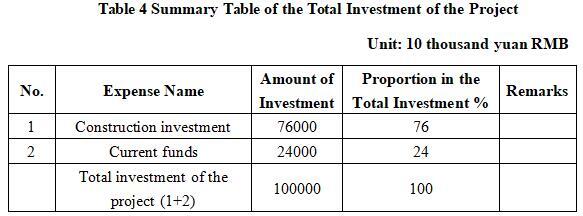
1.3.2 Capital raising
Self-raising by the enterprise
1.4 Financial analysis and social evaluation
1.4.1 Main financial indexes
After the project reaches the production capacity, its annual sales income will be 566.67 million yuan, its profit will be 290.7 million yuan, its investment payback period will be 6.3 years (after the tax, including the construction period of 2 years) and its return on investment will be 29%.
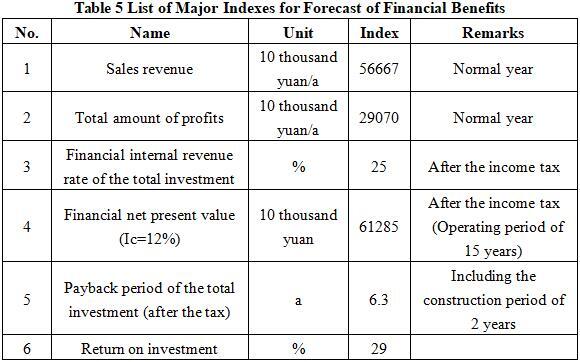
Note: “10 thousand yuan” in the table is in RMB.
1.4.2 Social evaluation
The rural tourism resort-style park project not only showcases the technological achievements and management experience of modern agriculture, but also integrates rich agricultural culture and historical heritage. Through agricultural culture museums, agricultural technology exhibitions, and other venues, visitors can experience the development history and traditional culture of agriculture, enhancing their understanding and interest in agriculture. At the same time, the project can also promote innovation and development of agricultural culture, and promote the deep integration of agriculture with tourism, culture and other industries.
The construction of the project can enhance the image and visibility of the city. As a modern agricultural themed park that integrates tourism, leisure, entertainment, health preservation, education, and residential functions, it will attract a large number of tourists to visit and experience. This not only helps to enhance the visibility and reputation of Jilin City, but also promotes the development of local tourism and the prosperity of related industries.
1.5 Cooperative way
Joint venture or cooperation, and other methods can be discussed face-to-face.
1.6 What to be invested by the foreign party
Funds, and other methods can be discussed face-to-face.
1.7 Construction site of the project
Ice and Snow Economy High-quality Development Experimental Zone, Jilin City, Jilin Province.
1.8 Progress of the project
It is in the planning phase.
2. Introduction to the Partner
2.1 Basic information
Name: Management Committee of Ice and Snow Economy High-quality Development Experimental Zone of Jilin City
Address: Beidahu Ski Resort, Jilin City
2.2 Overview
The Ice and Snow Economy High-quality Development Experimental Zone of Jilin City is located in the southern part of Jilin City, with an area of 1353.9 square kilometers. It consists of three parts: Jilin Beidahu Sports Tourism Economic Development Area, Jilin Songhua Lake Scenic Area, and Vanke Songhua Lake Resort. It integrates the top three snow field resources in the country and is the only provincial-level ice and snow economy high-quality development platform in the country. Jilin Beidahu Sports Tourism Economic Development Area was established in April 2003 with the approval of Jilin Provincial People’s Government. It is currently the only provincial-level development zone in China with sports tourism as its leading industry. The planned control area is 126 square kilometers, with a core area of 35 square kilometers.
2.3 Contact method
Postal code: 132000
Contact person: Duan Mingkui
Tel: +86-432-64202626
+86-18643213711
E-mail: 1419035232@qq.com
Contact method of the city (prefecture) where the project is located:
Contact unit: Investment Promotion Service Center of Jilin Bureau of Commerce
Contact person: Jiang Yuxiu
Tel: +86-432-62049694
+86-15804325460
E-mail: jlstzcjfwzx@163.com


